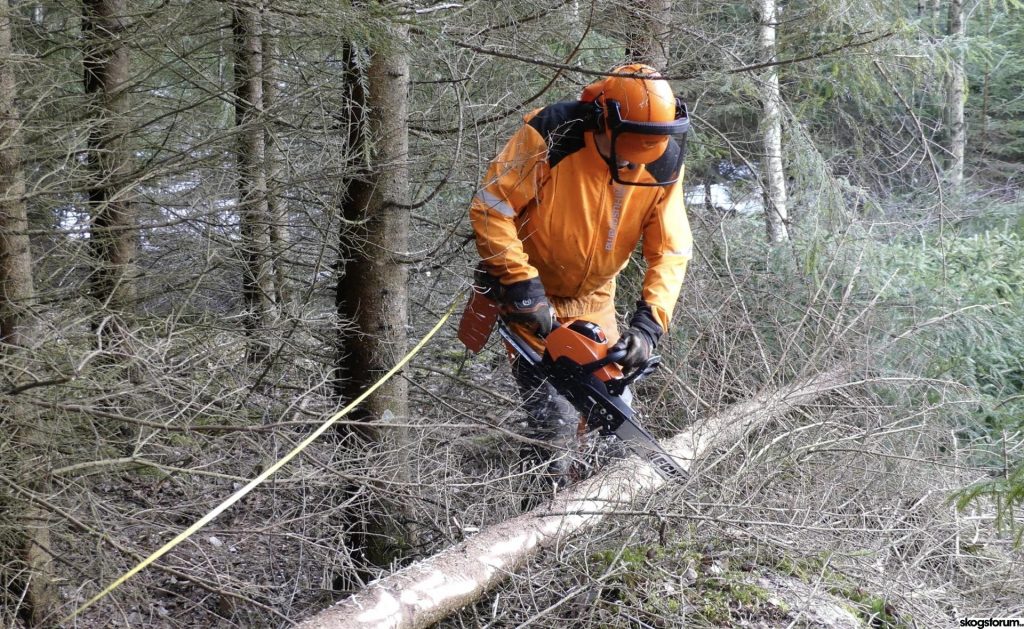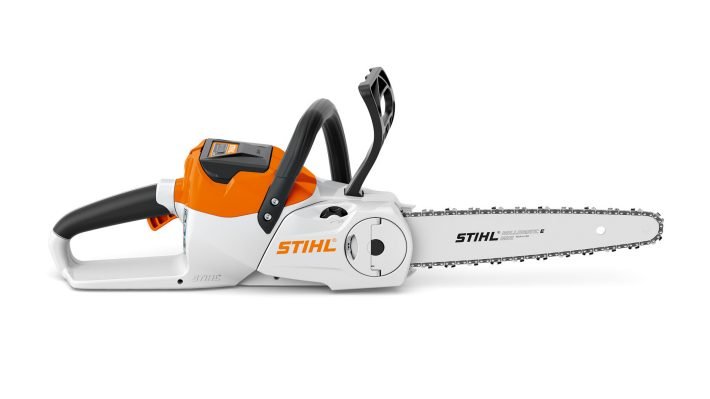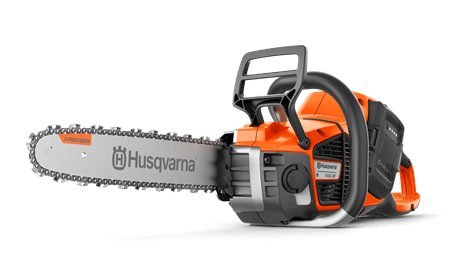In the last few years a lot has happened in the development of batteries for electrical chainsaws. Husqvarna (Husky), Stihl and others race each other to have the best and most long-lasting batteries for their chain- and clearing saws. But what is the best? Battery or gas? Will the battery saws take over?
Gasoline vs. batteries
Chainsaws with electrical engines is nothing new. Garden saws with long cables were available already at least 40 years ago. They were however nothing for the forest. I don´t know exactly when battery saws turned up, but it took some years before the battery capacity was long enough to be interesting for professional use in the forest.
Now, both Husky, Stihl and Echo offer battery saws for professional forestry use. Even I have for the first time in my life tried one, an Echo DCS 1600 that I got to try when we tested a bunch of Echo saws earlier this year.
Some personal reflections on the battery saw
As this is my only personal experience of battery saws, I must also refer to what I hear and read from others. When reading discussions on e.g. the sister site Skogsforum.se you soon notice that there are two groups that are easy to see: The haters and the lovers of battery saws. That kind of discussion is however not very interesting as neither side ever will listen to the other anyway. So, it´s better to make your own experience, as I did.
My impression of the battery saw I tested was that it was quick, strong, clean and silent. The acceleration is fantastic when you are used to an ordinary chainsaw. The battery saw is not completely silent. You may dream about working with it without ear protection, but that you can forget. It is more silent than a gas driven chainsaw but the chain itself make enough noise to damage your ears. Besides, you will still need the helmet as you are felling trees, so to not use the earmuffs seem stupid.
The silence is not only good. When you sharpen the chain or do some other maintenance, you have to realize that the saw is active until you turn it off. There is no “idling noise”. If you accidently should give gas when filing, you can get nasty injuries. You must turn the main switch off or even better, remove the battery during maintenance.
You also have to keep an eye on the oil level in the oil tank as the running time on a battery doesn´t correspond to the oil consumption as is common on normal chainsaws. The battery on the saw I tested ran out of power way before the oil tank was empty. A good habit in that case is to fill the oil tank when you switch battery and the problem won´t be noticeable.
As for the battery, this is the major downside of the battery saw. There are different battery options. Husqvarna, as for an example, offer a large battery pack that you carry on your back. This option has a comparably long running time. But the battery in the Echo 1600 only lasted 35 minutes in a young spruce thinning. That means you will have to carry 12 – 15 batteries with you to the forest every day if you work normal hours. Sadly, they are just as heavy when you go home in the afternoon as they were in the morning. This is something that must be improved a lot before I am fully convinced of the benefits with battery saws.
Photo: Stihl.de
Different areas to use the battery saw
As being a logger, an old-fashioned one, I only think of logging when it comes to chainsaws. But there are other areas where they are used. I can imagine that if you are climbing trees as an arborist, a battery saw is worth gold. The fact that you don´t have to pull the string when starting the saw must be enough for an arborist to choose battery before gas.
Also, for park management in general, where the saw is used only a couple of times a day and a battery charger is close all the time, the battery saw must be an easy choice.
Finally, if you only used a chainsaw to cut firewood in the back yard, a battery saw must be the best option. In this case you could even use a saw with a cable. The neighbors will like it because of the low noise level.
Photo: Husqvarna.com
Pros and cons
Here below I have tried to sort out the pros and cons of battery vs. gas according to what I´ve heard, experienced and read.
Battery
+
On the plus-side for battery saws we have to mention the environment. You don´t need gasoline and we have no exhaust which make the working environment for the operator better.
Some (older?) people seem to like the battery saws as they don´t have to pull the string to start the saw. Also, for arborists/climbers it should be a benefit to not having to start the saw by pulling. With a battery saw you just have to push a button.
The noise – well, the battery saw also make some noise, but of another kind. Anyway, it is a bit more silent than the gas saw, especially at a distance. The neighbors won´t hear you.
The batteries and saw together might be expensive compared to an ordinary saw and a can of gas. On the other hand, a can of gas only lasts for a day, so in the long run the battery saw should be cheaper. That is of course dependent on what you pay for electricity when you charge the batteries, and how much you use the saw. Chain oil you will need in both cases.
–
As for chain oil, some claims it´s difficult to know when it´s time to refill the oil tank. With an ordinary saw you fill the oil when you fill the gas tank. Some brands however, e.g. Husqvarna, Stihl and Echo, have a level window on the oil tank where you can see the current oil level.
The weight – the batteries are just as heavy in the afternoon when you go home as they were in the morning when you arrived in the forest. The gas can is much lighter when you go home. Otherwise, I think the weight of the saw is comparable to an ordinary chainsaw.
When it comes to how long a battery lasts, it seems to differ a lot. It comes down to what kind of battery you use and what kind of job you do, but as far as I understand you can count on 30 – 60 minutes operating time. 60 minutes would be ok, but 30 is too short. Anyway, the experience of batteries on other applications can make you hesitate. But then of course batteries are getting better and better. One can only hope that newer and better batteries also will fit older saw models.
It seems that when the battery is empty the saw just stops, compared to a gas saw where you notice quite early that you are about to run out of gas. The sudden stop could be a problem if you are halfway through when felling a big tree. There is a power meter on the battery, but it is quite rough.
An issue that has been mentioned by the German research center KWF (The German Centre for Forest Work and Technology) is the transport of broken batteries. They claim that here should be special boxes for this purpose available on the market, which is not the case for the moment according to the KWF test committee.
Gasoline
+
Old, reliable and familiar. It´s always a comfort in using equipment you have always used. You know how it works and how to solve problems when they occur.
Cheaper to buy which make it cheaper in the short term.
For the moment there are more models to choose from compared to the battery saws.
You can hear when the saw is active.
The gas can is lighter in the afternoon when you head for home than it was in the morning.
A tank full of gas lasts longer than most batteries. That will, however, most likely change in a few years’ time.
Gas and oil run out about the same time.
–
Exhaust gases make the working environment unsound.
Gas driven saws will soon (?) be out of date.
They are noisy.
Conclusion
There are probably more both pros and cons with the two types of chainsaws. I don´t think one excludes the other. It´s all up to what you use them for. If you are an arborist there shouldn´t be a doubt that the battery saw is the better option. But if you are a full-time logger, you should probably stay with the gas option a few more years until the battery capacity has improved.
I think we can count on that the battery saws will take over in some years’ time whether we like it or not. In this article I refer to gas driven saws as “ordinary” or “normal” chainsaws. Maybe it´s just a matter of time before the battery saw is the normal one? Also us older guys sometimes have to accept progress.
Find out more
Here you can read about Stihl battery saws.














